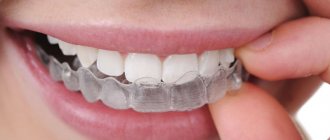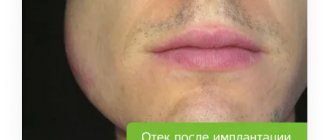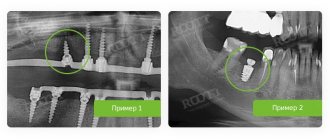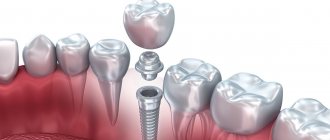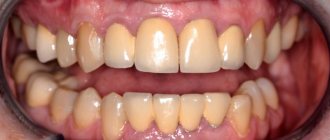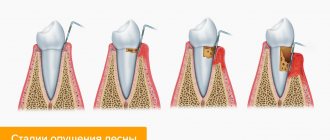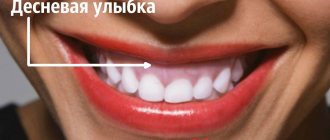Appearance of the gum former
The gum former looks like a thick screw with a small thread pitch. On its upper part there is a thick head. The diameter and shape of the upper surface of the head exactly corresponds to the base of the future tooth, and the lower part of the head, accordingly, has the shape of the top of an already installed artificial root. It turns out that the gum former exactly repeats the shape of the teeth and roots in their normal state.
The pin of the gum former has a thread that serves to screw it tightly into the artificial tooth root.
Gum formers are made individually and only for one specific tooth. This device is designed to form a hole in the gum where the artificial tooth will be located. The success of the installation of the gum former determines how tightly the artificial tooth will adhere to the gum. This is a very important point. The fact is that if the gum does not fit tightly around the tooth, then food will get into the gap. It is not so easy to remove it from there, and therefore gum inflammation is possible.
Why does the gum former get twisted or fall out?
- Loose abutment of the former caused by excessively deep implantation of the titanium pin into the bone. Bone tissue grows on top of the implant, which prevents the former from being firmly attached.
- Incorrect choice of size or shape of the structure, poor-quality thread manufacturing.
- Poor adhesion of the rod to the bone due to the low density of the latter.
- Development of the inflammatory process.
The patient's action when the former is wobbly or twisted is to urgently contact the dental clinic to avoid worsening the situation.
The doctor will re-screw the former or install a new one. If the procedure is not carried out in time, the hole will become overgrown, which will require repeated cutting of the gums.
Doctor's actions:
- If the implant was installed too deeply, excess bone tissue must be removed.
- If jaw bone density is low, calcium-containing medications are prescribed.
- If the cause is the development of inflammation, then removal of the artificial root and former will be required.
- The doctor can tighten the thread or replace the former.
What is the gum abutment made of?
The best material for making a gum former is titanium. This metal is very light and extremely durable. In an aggressive environment, and the oral cavity is such for metal, titanium does not oxidize at all. In essence, this would be an ideal option for such a product, if not for one “but”.
The fact is that titanium is visible through the gum. For those people whose gums are visible when they smile, this option is not suitable. They prefer to install a healing abutment made of zirconium. This material does not have this drawback.
Why can an implant unscrew from the gum?
Unscrewing an implant from the gum is a rare occurrence, but such cases do occur. The loss of a titanium rod is not always the fault of the implantologist; sometimes the patient himself or the manufacturer is to blame. When unscrewing the implant, you need to pay attention to how long after implantation this happened. If the incident occurred in the first weeks, we can conclude that the implantologist is to blame.
Reasons may be:
- insufficient study of the patient's medical history;
- improper antiseptic treatment;
- poor quality tool;
- melting of the bone due to incorrectly calculated load and selection of an inappropriate dental system.
In all these cases, the patient may experience peri-implantitis, accompanied by tissue destruction and granulation. Treatment of the lesion in the oral cavity and treatment of the upper and lower parts of the structure are required. In advanced cases, the only way out is to remove the entire structure.
In case of early unscrewing of the implant, you need to send a complaint to the manufacturer. Possibly the reason was poor quality material.
The removal of the titanium root can also be caused by applying excessive force when unscrewing the plug or former. If the implant began to wobble and fell out much later (at least after 1-2 years), the patient himself is most likely to blame. The structure could have come loose due to non-compliance with hygiene rules or the dentist’s recommendations.
Abutment and healing abutment
The technology of implanting artificial teeth along with gum formers allows the use of abutments. This is a completely different device, designed for installation in an artificial root after the gums have formed. It is installed in place of the gum former and serves to fit the tooth more tightly into the root.
The top of the abutment has a completely different shape than the healing abutment. It is made individually for each tooth. There are several types of abutments: temporary, standard, angled, cast and custom. These devices are made of ceramic, titanium, gold, plastic or special alloys.
Classification
In dentistry, it is customary to classify gum formers according to quality of manufacture and cost.
The economy class includes gum formers produced by Adin, Alpha Bio, MIS, Iterum (Israel), Bicon (USA), Implantium (Korea, USA).
Business class products are produced by the only German company in the world, Xive. Manufacturers of premium gum holders are Straumann (Switzerland), Astra tech (Sweden), Nico, Ankylos, Impro, Semandos (Germany), Nobel Biocare (USA).
Even though gum formers from one company are suitable for installing implants from other companies, dentists still recommend using all products from the same manufacturer.
One-step installation method
With the one-step installation method, fixation in a special socket is carried out immediately after implantation . In this case, excision of soft tissue is not required.
Important! The standard method is considered more reliable, since the “plug” is fixed to an already established artificial tooth. The advantage of the one-step method is time saving . This method is suitable for young patients with strong jawbone.
Gum former: how long does it take to heal?
The former is a temporary structure that must be removed immediately after the wound has healed. Healing takes 2-3 weeks , swelling goes away within a week . During this time, the gums acquire the shape necessary for further work.
Photo 1. Photograph of the oral cavity with the formers installed in place of the missing teeth.
A month later , if the structure has not unraveled and the patient has not experienced any complications, the product is removed by a doctor . After removal, an abutment and crown are installed.
Installation sequence
The length of time required to prepare for the placement of a healing abutment may vary. This depends on the extent of preparatory measures. Sometimes this process lasts for six months, and sometimes only for a few days. The operation itself does not last long. During a standard installation, it is done in the following sequence:
- - local anesthesia is given;
- — an incision is made in soft tissue to gain access to the fastening;
- - excess soft tissue is cut out;
- — the plug is removed from the implant;
- — manually or with a ratchet, screw the former into the root.
- - stitches are placed on the cuts.
Installation
The most progressive method of restoring an attractive smile today is immediate or “one-day” implantation. In this case, the dentist installs the pin itself and a temporary crown made of plastic or acrylic in just a few hours of work. In this case, tissue deformation is simply excluded, and the aesthetics of the dentition is not disturbed, so there is no point in attaching the former.
Where is the shaper installed? An implant of any size has a small recess; it is designed specifically for screwing in an adapter (abutment) or gum former. If the load occurs on the same day as the installation of the artificial root, then the cylinder is screwed in immediately. This does not require sutures, which makes the procedure less traumatic.
After the implantation of the structure and in the absence of any complications, the cylinder is carefully removed several months later. In its place, a smooth and even hole is formed, where a temporary and then a permanent crown will be fixed.
How long do you have to wear a gum former?
After installation of the former, the gums usually heal within a week, but this does not happen in all patients. In any case, only the doctor determines the readiness of the oral cavity for surgery.
Separately, it is necessary to say about bleeding from the gums after installing the former. For most patients, this ends on the second or third day. However, for many, the ichor oozes for much longer. You shouldn’t be afraid of this, since these are simply individual characteristics of the body in terms of blood clotting. Statistics show that you have to wear a gum former for no longer than two weeks. After this, the former is unscrewed to take an impression for the prosthesis.
The essence of the formation of the hole is the flow of soft tissues around the gum former. Of course, they cannot adhere to the surface of the former, but they adhere to it very tightly. As a rule, this process occurs evenly along the entire circumference of the former. Only in rare cases does the overgrowth occur unevenly. In this case, surgical intervention is required.
Formation of gums after dental implantation
Installation of the former - implantation stage. The condition for installing an implant is elastic and correct gum contour , which, with the help of this orthodontic device, acquires the correct shape, and the soft tissue subsequently fits more tightly to the crown, which increases the stability of the implant.
Important! Do not confuse the former and the abutment. The former is a temporary structure and is removed from the oral cavity when it performs its role. The purpose of the abutment is to hold the parts of the implant together .
Possible complications after the installation of a gum former
Unfortunately, the process of gum formation can be complicated by considerable troubles. Most often they are caused by a doctor’s error, less often by the characteristics of the patient’s body.
The doctor’s mistake is also considered to be the fact that he did not find out whether the patient is susceptible to an allergic reaction to painkillers. If such a reaction exists, then after installing the former in the patient’s oral cavity, an inflammatory process may begin. It should be said that the shaper itself cannot cause an allergic reaction.
Sometimes after installing the shaper, the pain does not disappear, but, on the contrary, intensifies. This is a sign of inflammation of the soft tissues or a violation of the tightness of the sutures. In this case, the patient is prescribed antibiotics and new sutures are placed. Sometimes swelling of the cheek occurs after surgery. This is not an anomaly, and the swelling soon goes away on its own.
It also happens that the former puts too much pressure on the gum, causing it to become inflamed. In this case, all the blame lies with the doctor, because he incorrectly calculated the size of the shaper. Such a former has to be replaced with another. It is very bad if the shaper begins to wobble a few days after installation. This can happen from a loose fit into the root or a loose fit of the artificial root into the bone. A loose root may be due to insufficient bone density. In this case, the doctor prescribes calcium for use. If the density of the bone tissue is high, and the former wobbles along with the root, it means that the body has not accepted the foreign body and rejects it. Soon an inflammatory process will begin under the root. To avoid this, the former is removed along with the root.
Sometimes the gums bleed for a long time under the stitches, although the stitches were applied correctly. There is only one reason for this: the patient’s weak blood clotting ability. In this case, you should definitely consult a doctor.
It is very important to know that if you do not follow all the doctor's recommendations, then in the postoperative period you may experience such unpleasant things as tumors, toothache, neck pain or sore throat and ear.
What to do if the shaper falls out
Sometimes it happens that the element gets twisted and falls out of the implant. A correctly installed element protrudes above the mucous membrane by only 1.5-2 mm. The main cause of superstructure failure is inappropriate torque force or increased bone looseness, which causes the component to become loose and not hold in the implant. If the gum former falls out of the implant, you should immediately consult a doctor. Its long-term absence will lead to overgrowth of the hole, and the mucous membrane will need to be opened again.
Author of the article Voznyuk Vladimir Aleksandrovich Maxillofacial surgeon-implantologist of the highest category
Experience more than 30 years
What can happen if the healing abutment is not installed correctly?
Correct installation of the gum former is a guarantee that the implantation of an artificial tooth will be completed successfully because the socket for the prosthesis will be formed as needed. If the shaper is not installed accurately, then the hole will not be formed as it should be.
If the root is planted too deep into the bone, then the former will not be installed correctly. Soon it will begin to wobble and then fall out. This happens because bone tissue will begin to grow on the root and displace the former. In such a situation, the doctor cuts off the growth of bone tissue, and the structure will soon strengthen itself.
If the former suddenly falls out of the root, you need to immediately screw it into place yourself and see a doctor as quickly as possible. You cannot delay your visit, because the hole begins to overgrow very quickly. A late visit means that you will have to start installing the former again, which means cutting the gum again.
It also happens that the soft gum tissue completely covers the entire former. This is the result of a doctor’s mistake who incorrectly calculated the size of the shaper. In this case, you have to install a new, higher former. An incorrectly installed gum former that is too high causes discomfort when eating. This situation also requires replacing the former with a lower one.
Causes of loss
There are several reasons why your gum abutment can fall out. This may occur due to the implant being seated too deeply in the bone tissue cavity. Due to the growth on top of the mucous membrane structure, the fastening of the part becomes insufficiently reliable. This can also be caused by low qualifications of the specialist who performs the operation. If the parameters of the implant and former are selected incorrectly, sooner or later a loss will occur.
Other common reasons for the loss of an element: the presence of inflammatory processes in tissues, loose bones, etc. If the first signs of prolapse are detected, the patient should immediately contact the clinic. After a thorough inspection, the former will be installed back or replaced with a new one. Delay in this situation is unacceptable; it can cause gum overgrowth. To prevent hair loss, your doctor may prescribe a course of calcium supplements.
previous post
Dental implantation Osstem
next entry
How to care for your mouth after a gum former is installed?
After installing the gum former, you need to take care of your oral cavity in full, but in a gentle manner. The first thing we recommend is to change your hard toothbrush to a soft one. In this case, when brushing your teeth, you will not disturb the gums, and most importantly, the stitches. At this time, you need to brush your teeth without any pressure on the brush. If you want, you don’t need to clean them, but gently iron them. If the former suddenly falls out while brushing your teeth or eating, you should screw it back into place and immediately go to the doctor. Along with brushing your teeth, it is recommended to rinse your mouth with a saturated saline solution several times a day during the postoperative period. It is best to use sea or iodized salt. This procedure successfully prevents the occurrence of inflammatory processes.
A solution of hydrogen peroxide, tincture of calendula flowers, a decoction of echinacea root, a mixture of honey and salt, and some essential oils have similar properties.
Indications for installation
The jaw bone in the area of the missing tooth ceases to receive the necessary load and gradually begins to dissolve. Periodontal tissues lose their elasticity and sag. Subsidence of soft tissues is a direct indication for the use of a forming component. The element prepares the gums for the installation of a prosthesis.
A periodontal ridge is formed around the part, which further stabilizes the implant during the period of its osseointegration. The doctor keeps the process of soft tissue growth under control by determining the time for removing the former and installing the abutment.
Advice for pregnant women
In case of emergency, dental implantation can be done during pregnancy, but there are strict restrictions. So, this is strictly forbidden to do this in the first and third trimester, but in the second trimester it is possible. In this case, it is necessary to take into account the likelihood that after installing the gum former, the patient will have to take medications. This is not at all desirable for the fetus. The second point is that when installing a gum former, local anesthesia is used, and this will certainly affect the condition of the fetus. If it is possible to postpone implantation until the baby is born, then it is better to do just that.
What to do if the screw in the crown comes out
Loosening of a screw in an installed screw-retained crown can occur if:
- the crown had initially poor proximal contacts and the patient was able to unscrew the loose screw;
- there is loosening of the screw with initially good approximal contacts.
If there is rotation of an implant with a cement-fixed crown , there is one way to fix the problem - change the cement fixation to a screw one. In this case, it is necessary to provide access to the screw to create the shaft. This will require drilling a hole in the crown, but first you need to accurately calculate the projection of the screw head on the occlusal surface.
It is impossible to solve the problem of a loose screw on your own, so the patient needs to see a dentist.
How expensive is implantation?
In conclusion, let’s say a few words about the cost of dental implantation. The cost of this operation largely depends not on the cost of dental labor, but on the cost of the materials from which the implants are made. In addition, real prestige and the manufacturer’s own self-esteem bring their own adjustments to pricing.
Also, the price depends on the class of implants; the higher it is, the higher the price. The cost of implants from European manufacturers is much higher than that of their American and Australian counterparts.
The most inexpensive implants currently are Israeli ones.
Content
- Description of the problem
- Reasons for implant rejection
- Causes of gum abutment loss
- Features of the patient's body
- What are the consequences of ignoring doctor's recommendations?
- Rejection symptoms
- The implant fell out - what to do?
The use of implants to restore teeth is the most successful procedure in dentistry. But complications can arise with any surgical intervention, even in our time of high dental technology. Is it possible to improve the situation, and what should be done?
Recommendations for tissue healing
After completion of the mini-surgery, it is contraindicated to eat and drink for three hours. This restriction must be observed to avoid introducing infection into injured tissue. For pain, it is recommended to take painkillers; for nervous tension, valerian tablets.
Smoking is strictly prohibited for two days after implant placement.
While smoking a cigarette, the sutures placed by the orthopedist may come apart and the implant will come out. During puffing, the pressure inside the oral cavity changes, a sudden change in which should absolutely not be allowed. You will have to forget about cigarettes for 2-3 days, as well as about visiting a Russian steam room or sauna.
In order not to cause the sutures to diverge and the implant to fall out, you should not engage in heavy physical labor or heavy lifting.
Food should be pureed or liquid, moderately hot and not cold. It is forbidden to eat hard or sticky foods - this will cause the implanted pin to fall out. Sour, salty, pickled, spicy - slows down the healing of injured tissues. Therefore, limit yourself to lean or diet food for these days.
Rinsing with decoctions of medicinal herbs will speed up the healing of the mucous membrane and prevent the development of foci of inflammation. The decoction can be prepared in advance according to the recipe and used after each snack. It is recommended to rinse the mouth with warm liquid: just hold the broth in the mouth and spit. Instead of herbal decoctions, you can use miramistin or chlorhexidine.
Cleaning the oral cavity should be done with great care, using cleaning products and brushes recommended by your podiatrist. It is important not to provoke bleeding from the wound. Instead of a toothbrush, you can use an irrigator, which gently cleanses the oral cavity with a directed stream of water. However, the jet pressure should not be strong; it should be adjusted.
If the former falls out while eating or brushing your teeth, you should put it back in place and notify your orthopedist.
How long do you wear a shaper? This depends on the condition of the patient’s oral mucous membranes. As soon as the edge of the gum acquires the necessary shape (contour), the temporary structure will be removed and replaced with a permanent one.
Installation during pregnancy
Serious hormonal changes occur in the body of the expectant mother. Metabolism is being restructured, because Fetal nutrition is carried out at the expense of the resources of the mother's body. Against this background, the expectant mother’s immunity decreases, bones and teeth become more fragile. Therefore, dentists do not recommend dental implantation during pregnancy and lactation - so as not to burden the body and not harm the baby with medications.
However, a gum abutment is a more routine procedure. If you are faced with the fact that you had an implant installed before pregnancy and the need to fix the former fell just during this period, it is still worth postponing this stage until after the birth of the baby. After all, both the surgical intervention itself and the local anesthesia that is given during any treatment pose a rather great danger. In addition to the anesthetic, the injection may contain epinephrine (adrenaline), which is contraindicated for pregnant women. In exceptional cases, the installation of a former is allowed only in the second trimester of pregnancy and only with the permission of an obstetrician-gynecologist and dentist. But it is better to postpone this procedure until lactation is completed and the body is completely restored.
Author: Vasiliev A. A. (Thank you for your help in writing the article and the information provided)
Anesthesia
If there is constant pain at the site where the former is installed, you need to do a gentle massage of the gums with tea tree essential oils, which help relieve pain.
A mixture of table salt (fine) and honey relieves pain well. For one part of salt, take 4 parts of liquid honey.
Baths made from infusion of calendula or echinacea flowers are good for pain relief. You should not rinse your mouth, but simply keep the liquid in your mouth and spit. The decoction should be used warm; you should not rinse your mouth with hot liquid - this will cause bleeding. A decoction of echinacea or calendula prevents the development of inflammatory processes.
Impact of the shaper
A rubber connection with a cylindrical head makes up the design of the gum former, which is made of titanium. The thread is used for fixation on the implant. The cylindrical head creates a natural depression in the gum to restore its shape. This ensures a tight fit of the crown to the mucosa.
The orthopedic dentist selects a gum former for the patient according to individual parameters. This is possible thanks to a wide selection of shapes and sizes of such structures in the range of manufacturers of implant systems. You can select a former that is suitable for installation in case of implantation carried out in one or two stages.
Materials for production
The healing abutment must withstand significant loads. That is why it is made only from durable materials. Often the structure is made of titanium, which differs in many respects from other metals and reduces the load on the root system of the oral cavity.
But it also has a number of disadvantages. Among them is the transmission of the structure through the gums. This spoils the appearance especially in cases where it is installed on the front teeth.
The former can also be made of zirconium. The material is resistant to external factors and, if installed correctly, can last a long time.
Less durable materials are plastic and ceramics. After a certain time of use, they require replacement, as they are not resistant to erosion. The choice of material from which the former will be made depends on many factors, for example, the individual characteristics of the patient and the subsequent stages of installation of artificial teeth.
Material and manufacturers
The formers are made of titanium and zirconium. These metals do not corrode and do not cause tissue rejection. Zirconium is installed on the smile line, since it does not shine through the gums and does not stand out against the background of the mucous membrane tissue. A titanium pin is placed on the area of the chewing molars (from the side). The temporary abutment is selected according to individual parameters for each patient separately.
Orthopedic systems are produced by different manufacturers, many of which are branded. All orthopedic products are divided into three classes:
- Premium;
- business;
- economy
Prices for orthopedic products depend on the material, class and manufacturer. Premium products include shapers from Switzerland (Straumann), the United States (Nobel) and Sweden (Astra Tech). Business class products are manufactured by the German company Xive. Inexpensive ones are produced in South Korea and Israel.
Among economy-class implants, Russians highlight Israeli products. It is distinguished by its quality at a low price, as well as a variety of models to choose from. Recently, medical tourism has gained popularity, which solves two problems at once - medical care and a pleasant vacation.
Israeli manufacturers of orthopedic systems:
- Adin;
- Alpha Bio;
- Ards;
- MIS;
- other.
Korean orthopedic products are also of high quality at a reasonable price. However, Korean orthopedics began to develop somewhat later than Israeli. The first Korean implants were created in 1992. Orthopedic dentists note the difficulty in the process of implanting Korean implants and labor-intensive osseointegration with the jaw tissue. Korean manufacturers are trying to surpass Israeli craftsmen in the quality of manufacturing orthopedic products, but so far there has been no noticeable success in this direction.
Korean manufacturers of orthopedic systems:
- Implantium;
- Osstem;
- Any One;
- other.
When choosing between Israeli and Korean orthopedic systems, trust the professionalism of the dentist. It is the doctor’s experience that plays the main role in installing prostheses.
